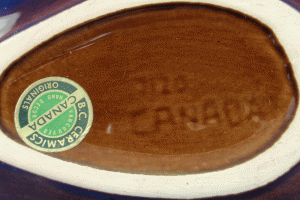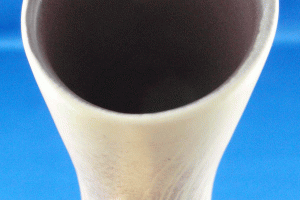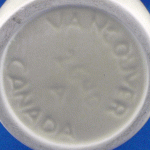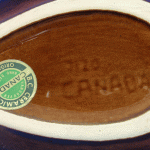It is surprisingly difficult to find in-depth information on the company, BC Ceramics. The following information was gathered many years ago as personal research, and I cannot currently find it anywhere online. I began with an article I found on the website, www.bcceramics.ca, (page not available), but I’d like to include information from it as I think it provides the most comprehensive background to the pottery.
Location & dates:
- 1954-1967 (Homer Street, Vancouver; distribution office in Toronto)
- 1967-1970 (Sunburst – Lethbridge)
People:
- Frederick Leuchte [See Royal Ariston]
- Walter Gerz (d.1967) – Ceramics Engineer: responsible for the technical aspects of the business, including glazes and design of plant equipment [1954-1967]
- Herta Gerz (1913-2005) – artist, décor designer, trainer [See Herta]
Markets: Department stores, Birks Jewellers across Canada, and foreign markets
Transitions: from Importex Company (Royal Ariston) to BC Ceramics (Vancouver) to Sunburst (Lethbridge)
The following info is from “BC Ceramics: History” by Allan Collier, Victoria, BC, written sometime before June 2012.
History
“BC Ceramics was a Vancouver-based ceramics company in business between 1954/55 and the early Seventies. The Company produced contemporary giftware…from its multi-storied facility on Homer Street in downtown Vancouver.
Common Forms and Shapes
“BC Ceramics produced hundreds of different items including dishes, bowls, vases, pitchers, ashtrays, candle holders, planters, promotional items, lamp bases, and figurines. While some are similar to designs by other manufacturers, many are unique to BC Ceramics.
“All products, except lamps, were marked with a clear 4-digit mould number which was most often impressed, but sometimes in relief or handwritten, on the bottom. Items with an “A” following the mould number are alternate versions or part of a pair (e.g.Salt and Pepper).
“Each number refers to a specific item or shape. A large percentage of these, including the lamp bases, ashtrays, bowls, vases, and other container forms, were available in about 20 common “decors”.
Decoration
“Apart from figurines, almost all BC Ceramics pieces were decorated with décors, native motifs, surface textures, and colour glazes unique to the company.
“Both glossy and matte glazes are common, often in several colours – “twintone”, mottled, or speckled – or in monochrome, plain black, gray, cream or white. Dimpled, rough surfaces and sgraffito markings are also evident on bowls and vases.
Identification
“In most cases, BC Ceramic pieces can be identified by form, mould number, or unique decoration alone. Fortunately, most items also have additional features, markings, or labels which makes identification that much easier.
“Practically all BC Ceramic articles have a well-formed and unglazed foot “ring” on the bottom. (Some dishes and shallow bowls have feet located at one end and no foot “ring”)
“Some pieces come with paper labels in one of several different styles or colours…there is also a label in the shape of a maple leaf.
“In addition to the 4-digit mould number – usually impressed, but sometimes in relief – many items have “Vancouver,” or “Canada” (or both) impressed on the bottom.
“Often, handwritten inscriptions such as “By Herta” or “Décor by Herta” or the name of the décor, appear on the bottom along with the mould number.”
The company ceased operations as BC Ceramics around 1970 when it was acquired by Sunburst Ceramics of Lethbridge, Alberta.
I will provide as much credit to the author as possible, and if anyone can provide me more info on the source, please contact me.
I would like to thank Allen Collier for the information provided.
This additional information came from Jim Meadows:
“I was the mold maker and managed the tunnel kiln at BC Ceramics in 1966 – 67 and was recently inspired to look into that history when I saw pieces by Herta Gerz at the “Modern in the Making” exhibit at the Vancouver Art Gallery – Allan Collier curated. The most memorable mold was my first custom piece made from the paw of a grizzly bear and turned into an ashtray (claws up!) for a lodge in the north. It was grotesque but also typical of many of the “kitch” designs they produced. Ten years later, the seed from that experience lead me to establish Great Canadian Design Works where we developed the technique of slip casting to produce very contemporary simple designs in porcelain. At that time, slip casting was looked down upon by the pottery community, but we eventually received recognition and I was asked to conduct workshops on the technique. Thank you for the information provided here.” [Comment received Jan 2021]











![7b: Herta “Wild Rose” pin dish, mould 7113 [mark]](https://canadapottery.ca/wp-content/uploads/2014/09/Herta-Wild-Rose-pin-dish-mould-7113-mark-150x150.gif)
Hello I’m trying to find out some information about this stone bakeware I believe the maker was from North Vancouver 1990 era. Thank you for any info you can provide.
Louise, I’m sorry, I don’t recognize the mark. Perhaps Barry Morrison of Studio Ceramics Canada would know. This looks like a studio piece, and I focus mainly on manufacturer’s ceramics. There is a place on Barry’s site for comments. He is very generous with his time and his knowledge. https://studioceramicscanada.com/
Are you familiar with the alter piece created for Lutheran Church in Vancouver by Gertz factory. Its motif is Christ arising from his grave. It’s painted and fired onto clay bricks totaling approx120 pcs. at the Gertz factory approx. 1955.A huge challenge for the factory artist and to get the red color correct. It’s now displayed at the new church on cambie/ash &41 st
Thank you, Rudy. I have not yet seen the piece you’ve mentioned. The church is on my list of places to visit once I’m comfortable with travel again. Thank you for this additional information. Your previous comments are included in the ‘Comments’ section of the BC Ceramics: Herta page, for anyone interested in more detailed info on this amazing piece of artwork by Herta. Thanks again. Maria.
I wanted to thank you for crediting me for the BC Ceramics information.
It originally appeared as bcceramics.ca but when the site was corrupted somehow, I did a new one which disappeared for some reason. It was all quite discouraging, so I left it.
I have been meaning to re-establish the site, but got too busy on various exhibitions, etc.
I am now researching potters’ marks for the new Ceramics Marks Registry (Craft Council of BC) and came to this site because of my interest in the Great Canadian Design Works and specifically Jim Meadows’s involvement. What a surprise to learn that he worked for BC Ceramics and applied what he learned there to his own business.
Please contact me, Jim. I would like to learn more about GCDW.I have at least 2 carafes and a wine glass and have always had a special interest in “mass-produced” ceramics. I agree it has been unjustifiably maligned. I consider my collection of Rosenthal, Purbeck, Poole, Portmeirion, Branksome, Wright, Zeisel etc to be among my favourite pieces.
Glad you saw Modern in the Making, Jim. I made a point of including BC Ceramics and Crown Ceramics, but it’s only the tip of the iceberg.
Hope to hear from you in the near future. AC
I’m so pleased you reached out. Your old website was invaluable for providing the info I was looking for on BC Ceramics. I believe I still have your email granting me permission to use the information on there for my own research. Thanks again, for your contribution to the study of ‘mass-produced’ 20th-century Canadian pottery. I do hope that Jim Meadows contacts you. I will see if I have his contact information and can then pass along your message.
Maria
Hi Allen,
I would be delighted to hear from you – I currently live on Salt Spring Island but come to Vancouver occasionally. After a 35 year hiatus I have once again put my creative energy to ceramics and am exploring slip-cast terracotta. By “mass-produced” I assume you’re referring to 100 bowls thrown on a wheel?
Cheers,
Jim
jimmeadows@shaw.ca
I have a beautiful small green thin necked vase with CANADA 2640 on the base. It was given to me by my mother-in-law before she passed. I would love to know more about the history of it, but also ask if it is possible to fix the tiny chip on the lip edge of it
Jenni, your vase is most likely a BC Ceramics piece, but without a picture of the vase and base, I cannot say for sure. As to getting the chip repaired, you would need to ask a ceramicist or potter that question. I would say, however, that the cost of getting someone to repair it would cost more than the actual value. Of course, if you wish to repair it for sentimental reasons, check with your local pottery guild to see if it is an option.
Maria.
I was the mold maker and managed the tunnel kiln at BC Ceramics in 1966 – 67 and was recently inspired to look into that history when I saw pieces by Herta Gerz at the “Modern in the Making” exhibit at the Vancouver Art Gallery – Allan Collier curated. The most memorable mold was my first custom piece made from the paw of a grizzly bear and turned into an ashtray (claws up!) for a lodge in the north. It was grotesque but also typical of many of the “kitch” designs they produced. Ten years later, the seed from that experience lead me to establish Great Canadian Design Works where we developed the technique of slip casting to produce very contemporary simple designs in porcelain. At that time, slip casting was looked down upon by the pottery community, but we eventually received recognition and I was asked to conduct workshops on the technique. Thank you for the information provided here.